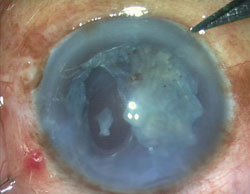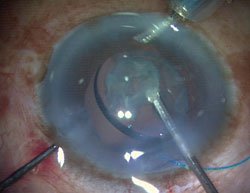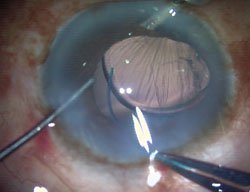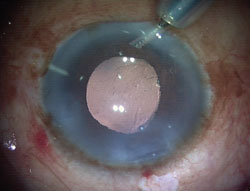IOL scaffolding technique helps prevent nucleus drop
It is not necessary to extend the corneal incision with this technique.
 Amar Agarwal |
Posterior capsular rupture is one of the common complications during phacoemulsification. Posterior capsular rupture with vitreous prolapse and the nucleus still in the capsular bag is an impending situation for nucleus drop. As a preventive step, it is normal for the cataract surgeon to extend the corneal incision and deliver the nucleus. Lens glide has also been used to remove the nuclear fragments. In the IOL scaffolding technique, we have used a foldable IOL as a scaffold for preventing nucleus drop without extending the incision.
Surgical technique
When there is a posterior capsule rupture with the nucleus in the bag, an anterior chamber maintainer is introduced (Figure 1). Anterior vitrectomy is done with the vitrectomy cutter to remove the vitreous prolapsed in the anterior chamber. While doing this, an Agarwal globe stabilization rod (Katena) pushes the fragment away from the posterior capsular rupture, thus preventing the nucleus from falling down. A foldable IOL is then injected via the existing corneal wound and is moved below the nucleus. The leading haptic of the IOL is positioned in the sulcus, and the trailing haptic is placed just out of the incision (Figure 2). The nucleus fragment is then removed with the vitrectomy cutter or a phaco probe, depending on the density of the nucleus. Once the whole nucleus is removed, the retained cortex is cleaned with the vitrectomy cutter with gentle aspiration. The other haptic of the IOL is then positioned in the ciliary sulcus (Figures 3 and 4) and the anterior chamber maintainer removed.
 Figure 1. Posterior capsular rupture during phacoemulsification of the nucleus. |
 Figure 2. Foldable IOL as a scaffold prevents the nucleus drop. Images: Agarwal A |
 Figure 3. Foldable IOL positioned in the ciliary sulcus. |
 Figure 4. IOL well-centered at the end of the procedure. |
Discussion
Although there have been techniques performed to prevent nucleus fragment from descending into the vitreous after intraoperative posterior capsular rupture, this IOL scaffolding method has not been reported. Conversion of phacoemulsification to extracapsular cataract extraction (ECCE) is done when a large nucleus is still left. Some surgeons prefer to use the lens glide to deliver the nucleus. In both conditions, corneal wound extension is required, and this can increase the risk of postoperative suture-induced astigmatism. Another way is nucleus removal by the phaco sandwich method, in which a vectis and a spatula are used. However, the incision in a phaco sandwich is sclerocorneal and requires extension. In eyes with nucleus displaced in the anterior vitreous, Viscoat (chondroitin sulfate, sodium hyaluronate, Alcon) posterior-assisted levitation is done followed by nucleus emulsification with the phaco probe above a trimmed sheet’s glide after wound extension. In the IOL scaffold technique, the wound remains clear corneal and there is no wound extension. The foldable IOL acts as the vitreous barrier and works like an artificial posterior capsule. Because one haptic is kept at the incision site, the IOL position can be readily adjusted if the nucleus rotates in the anterior chamber, and the chances of IOL drop are not there, as the haptic is controlled from the incision site.
When compared with an open wound (after extension), posterior capsular rupture during phacoemulsification is associated with a relatively low incidence of vitreous loss because the self-sealing small clear corneal wound provides control of ocular integrity. This maintains the anterior chamber and IOP, discouraging forward movement of the vitreous, which would occur in the presence of an open globe as in ECCE.
Conclusion
In this technique, the anterior chamber is maintained by slow infusion, forward movement of the vitreous is prevented by the IOL scaffold, and the nucleus fragment drop is stopped by the IOL, which acts as a physical barrier. Thus, we favor this new IOL scaffolding technique in posterior capsular rupture with non-emulsified moderate to soft nucleus during phacoemulsification. However, in cases of hard cataracts, conversion to ECCE is ideal.

- Amar Agarwal, MS, FRCS, FRCOphth, is director of Dr. Agarwal’s Eye Hospital and Eye Research Centre. Prof. Agarwal is the author of several books published by SLACK Incorporated, publisher of Ocular Surgery News, including Phaco Nightmares: Conquering Cataract Catastrophes, Bimanual Phaco: Mastering the Phakonit/MICS Technique, Dry Eye: A Practical Guide to Ocular Surface Disorders and Stem Cell Surgery and Presbyopia: A Surgical Textbook. He can be reached at 19 Cathedral Road, Chennai 600 086, India; fax: 91-44-28115871; email: dragarwal@vsnl.com; website: www.dragarwal.com.
- Disclosure: Dr. Agarwal is a consultant for AMO, Bausch + Lomb and STAAR Surgical. Dr. Kumar has no relevant financial disclosures.
